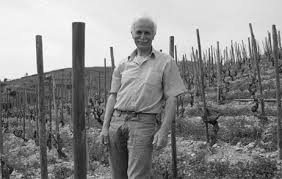Bernard Faurie is in a storied lineage working the same vines on the hill, the very same, some of the vines are over 100 years old.
The Estate vineyards are spread among three principal parcels of Hermitage: Bessards, Meal, and Greffieux.
Bessards and Meal are among the most storied portions of the hill.
Bernard subscribes to the philosophy that Hermitage is not really Hermitage unless it contains fruit from Bessards, the granite bedrock stronghold on the western edge of the hill.

Bernard Faurie, or should I say the family of Bernard Faurie has owned vines in Hermitage since 1935.
Bernard Faurie is the fourth generation of his family to work in Hermitage. Bernard Faurie learned the wine trade from his father.
In those days, their vineyard was divided between three relatives, each owning 0.56 hectares on the Hill of Hermitage.
The Estate produces two “basic” cuvees are red Hermitages in two different blends: Gréffieux/Bessards and Bessards/Méal.
I recent years, despite his predilection, they bottle a barrel of pure Meal.
On top, they also produce a very tiny quantity of Hermitage Blanc, an absolutely mesmerising example from the lower slopes of Bessards that is wiry, stony, and coiled for many years of unfurling.
Bernard’s wine has renewed a deep sense of understanding for us about what Hermitage really is, and what makes it special.
It is Syrah, of course, among the world’s best. It is grown on a granite hillside, like Cornas and much of Saint-Joseph.
But there is majesty to it, a nobility that you don’t find anywhere else. It is powerful yet fine.
The power is in its intensity and depth, not in concentration or obvious flair.
There is no rusticity. The finesse of the tannins, and of course its ability to age consistently and gracefully, are other trademarks.
It is nice to be reminded of how great this storied terroir can be in the hands of a master vigneron.
They have a steep hillside terroir of granite, rocks, quartz, clay, limestone and stone based soils.
Their oldest vines are on Greffieux, which are more than 100 years of age.
On Le Meal, the vines are close to 60 years of age.
In Hermitage, Bernard Faurie produces red Hermitage wines and 1 white Hermitage wine.
To produce the red Hermitage wines of Bernard Faurie, the grapes are whole cluster fermented in large, old, oak vats. the wines are aged in old, used demi-muids for between 18 to 24 months before bottling.
Previously, the wines were aged in old, oak barrels for up to 36 months, but that has since changed.
Since 1994, Bernard Faurie has produced 3 red Hermitage wines and one white Hermitage wine.
The specific vineyards where the vines are planted are not listed on the labels.
Instead, each of the 3 red wines from Bernard Faurie features different coloured capsules to help you tell them apart.
- Bernard Faurie with the cream coloured capsule is a blend of Syrah planted and Le Meal.
- Bernard Faurie with the plain gold capsule is produced from Syrah planted in the Greffieux Les Bessards vineyards.
- Bernard Faurie with the gold capsule featuring the letter M is made from 100% Syrah planted in the Le Meal lieu-dit.

Bernard Faurie Hermitage Blanc is produced from 100% old vine Marsanne.
The white wine is vinified in demi-muids, of which only 10% are new barrels.
The wine is aged for between 9 to 12 months before bottling.
Domaine Bernard Faurie
27 Avenue Helene de Tournon
07300 Tournon-sur-Rhone